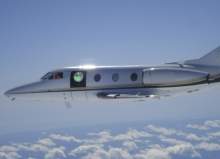

A research aircraft equipped with the turret, known as Aero-adaptive Aero-optic Beam Control (ABC), recently conducted a series of airworthiness test flights. The eight flight test flights with the Aero-optic Beam Control (ABC) turret were carried out by Lockheed Martin, the US Air Force Research Laboratory (AFRL) and the University of Notre Dame.
ABC is being developed for the Defense Advanced Research Projects Agency (DARPA) and AFRL to enable military aircraft to engage enemy aircraft and missiles above, below and behind the aircraft using high-energy lasers. Laser weapons have yet to be integrated with ABC; these flight tests are for the turret alone. As with any new payload that protrudes from an aircraft’s fuselage, ABC must be designed in such a way so as to not affect the performance and handling of the aircraft. Lockheed Martin used its flow control and optical compensation technologies counteract the effects of turbulence.
"These initial flight tests validate the performance of our ABC turret design, which is an enabler for integrating high energy lasers on military aircraft," said Doug Graham, vice president of advanced programmes at the strategic and missile defence systems department of Lockheed Martin Space Systems.
Laser turret but no laser
In a triumph of putting the cart before the horse, effective laser weapons that can be used from aircraft have yet to be developed. The US Department of Defense’s previous attempt to test an airborne laser weapon aboard the Boeing YAL-1 Airborne Laser (ABL) Testbed was abandoned in 2011, but had been roundly ridiculed throughout its lifespan. A high-energy laser was first fired from YAL-1 in 2009 and tests continued through early 2010. Even though it "successfully engaged" several target missiles, only a couple of them were successfully destroyed. One engagement had to be cut short due to a "beam misalignment" problem.
The US Department of Defense has revealed that its Laser Weapons System (LAWS) has successfully demonstrated its ability to down small aircraft during testing.
Recommending the cancellation of the project in 2009, Former US Secretary of Defense Robert Gates said: "I don’t know anybody at the Department of Defense who thinks that this programme should, or would, ever be operationally deployed. The reality is that you would need a laser something like 20 to 30 times more powerful than the chemical laser in the plane right now to be able to get any distance from the launch site to fire."
In case he hadn’t quite got his point across, he added for perspective: "So, right now the ABL would have to orbit inside the borders of Iran in order to be able to try and use its laser to shoot down that missile in the boost phase. And if you were to operationalise this you would be looking at 10 to 20 747s, at a billion and a half dollars apiece, and $100 million a year to operate. And there’s nobody in uniform that I know who believes that this is a workable concept."
Even the massive Laser Weapon System (LaWS) prototype that the US Navy plans to test aboard the US Navy’s Austin-class amphibious transport dock, USS Ponce, has to be aimed at the target for a few seconds to get it to burst into flame, like a magnifying glass in the sun. Using combined commercial welding lasers, it has generated 33 kW in testing, and the Navy intends a deployed version to generate up to 60-100 kW.
Solid state for less weight
While slab lasers deliver the hottest burn, solid state lasers are most likely to be chosen for use aboard aircraft because of their light weight. General Atomics is developing a single High Energy Liquid Laser Area Defense System (HELLADS) 150 kW laser for DARPA, with the first due for field testing this year, integrated with an existing US Air Force ground-based beam-control system. Lockheed Martin could also be in the running to develop a laser weapon to work with ABC – the company has been working on high-energy lasers for 30 years, alongside supporting technologies such as precision pointing and control, line-of-sight stabilisation and adaptive optics, and high-power fibre lasers.
So if effective lasers to use with ABC have not yet been developed, does the programme risk being dropped by the DoD as another YAL-1 farce? By working on accurate aiming first, it may have already stolen a march on its predecessor; as more powerful lasers come online, ABC will be able to maintain its target for as long as it takes to burst into flame, much like LaWS. No more "beam misalignment" problems.
Subsequent flight tests of ABC over the next year will demonstrate the turret in increasingly complex operations, and tests with a laser weapon against aerial targets could follow shortly afterwards. It remains to see whether this airborne laser weapon project will set the world alight or slowly smoulder into obscurity like YAL-1.
Follow Berenice Baker on Google+


.gif)

